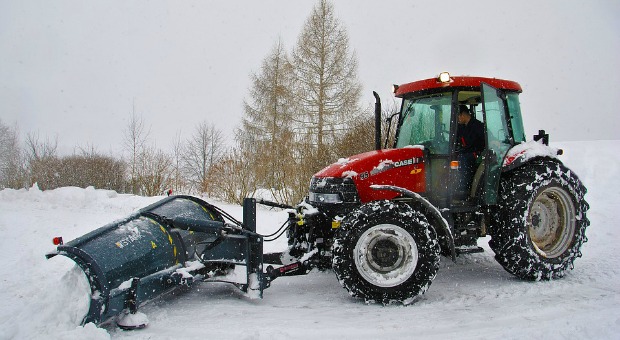Homesteaders and farmers recognize the importance of tractors in daily life. These vehicles tend to be very durable, but it’s important to make sure you can still use them in a post-crisis world.
Aside from increasing the number of things you can use the tractor for, taking these steps will also help your tractor last longer and perform better during its lifespan.
Know What the Tractor Can Do
Over the years, I’ve purchased all kinds of gadgets in my quest to find devices that use less electricity or power while delivering at or near the same level of usefulness as more conventional devices.
For example, when I was still learning how to use power tools, I thought battery powered tools would be better or safer than conventional ones. It wasn’t long before I found out that “under powered” means nothing more than slow and virtually useless.
To this day, my very first battery powered jigsaw sits in its original box somewhere in the attic, with a battery that I haven’t charged more than once every few years to see if it still works. At the same time, my conventional powered jigsaw sits right next to my desk and is always ready to use.
When it comes to preparing a tractor, it is very important to know just how much work they can do. Simply put, you cannot get an engine rated for 5 – 10 horsepower and expect it to do the work of a 25 horsepower engine.
If you are going to add accessories to the tractor, or in any other way expand what you use the tractor for, it is very important to know if the engine, drive train, and transmission can truly take the added wear and tear. The last thing you will want to do is purchase attachments or make plans only to find out that the tractor won’t suit your needs. Get a good sense of what your current tractor can do so that you can purchase something better or look for alternatives before it is too late.
Take control of your home’s energy with this step-by-step System to Energy Independence!
Buy Adapters that Expand their Usability
Did you know that you can purchase an adapter for a tractor that can be used to plow snow?
While many preppers think of tractors as farm and homestead equipment, they may also be useful to conventional homeowners and apartment dwellers. The sheer number of attachments and accessories for tractors make them as versatile as they are powerful.
Here are just a few attachments that you may find of use for homesteading as well as some others that can be used by just about any person that is concerned about having a versatile travel vehicle in time of need:
Forklift Attachment
It’s ideal for people that have large stockpiles stored in boxes or crates. The fork lift can be used to lift all kinds of heavy items at one time. Depending on size and power of the main tractor, a forklift may also be useful for lifting and pushing small vehicles out of the roadway.
Steel Tracks
No matter how big or sturdy tractor tires may be, muddy terrain or complex areas can be more easily navigated with steel tracks that give you advantages similar to what you would have with a tank.
Log Dragger
If you are planning to cut down large trees, you can easily haul the lumber with this tractor attachment.
Spade and Bucket Attachments
These devices will give you a chance to use the tractor as you would a backhoe.
Steel Enclosure
This should be one of the first things you buy, especially if you plan to use the tractor like a forklift or backhoe. The steel cage will keep you safe and may also make it easier to use the tractor in a wider range of weather situations.
Harrows, Scrapers, and Pipe Layers
There are all kinds of attachments for tractors that can be used for planting crops, or digging into the ground for some other purpose.
Get All Shop Manuals for the Tractor and Accessories
As with any other motor vehicle, you need as much information as possible about the parts and functionality of every system in your tractor. A shop manual will give you far more information than just how to exchange old parts for new ones. You may get a better look at what is inside each part so that you can refurbish the parts if needed.
These schematics will also help you gain a sense of additional skills and tools that might be of use to have on hand. For example, if a specific part has a rubber diaphragm, then you know that this part may be something that wears out faster than others. This information will show you what things are best to have in your stockpile. In this case, you will store away materials that can be used to make a new diaphragm as well as extra parts that can be changed out as needed.
When it comes to sourcing replacement materials for parts refurbishing, new polymer and resin technologies may offer better replacement materials. Once you get a look at the shop manual and study it carefully, you will know more about what kind of newer materials may work as well, if not better. Considering you may have to keep the tractor running for decades or even pass it along to future generations, you need as many suitable materials on hand as possible.
A shop manual will also give you a complete listing of every part used in the tractor. Did you know that it may be possible to scavenge parts from vehicles that aren’t the same make and model?
Usually, the key to achieving this goal is to know exactly where the mounting points are and if they can be adapted to your vehicle. Once again, the schematics for the parts used for your tractor will give you some good ideas about how the insides are arranged. This, in turn, makes it easier to estimate what can and cannot be done with scavenged parts.
Setup and Maintain a Maintenance Schedule
It is very easy to be inspired by all the power you wield when you have a tractor at your fingertips. On the other side of the equation, a tractor is still a machine that requires good quality routine maintenance to keep it working for as long as possible.
It’s all too easy to forget when the last oil change was, or when you carried out some other maintenance task. As with your car, setup and maintain a maintenance schedule for your tractor, based on the following:
- Consult the shop and owner’s manual so that you know what should be done at each maintenance interval.
- Include a listing of all materials and tools that you will need.
- Identify any areas where you feel that you do not have the knowledge or skills to do the job yourself. Even if you cannot do the job at the nearest time interval, make it your business to get the necessary training to do the job the next time it is needed.
- Set aside enough time so that you can do the job yourself and be sure that you are doing it well.
When it comes to prepping, there are some additional things you should add to your maintenance plans. Consider a situation where you have been doing routine maintenance, but haven’t done any tests to check on the engine compression. Even though the tractor is operating just fine, wear and tear is going to add up over time.
It is best to have some advance warning of parts that may fail so that you can be ready to repair or replace as needed. You will need to consult the shop manual and research each part of the tractor. The more you learn about the risks, the better chance you have of developing tests that will help you diagnose and repair in time.
Convert for Multiple Fuel Use
Just about every prepper is aware about the lack of fuel for motor vehicles in the post crisis world; this topic comes up as often, if not more than EMP proofing. Even though many tractors run on diesel, make sure that you have systems in place that can take advantage of biodiesel, wood burning and methane.
One of the most fascinating emerging technologies involves using hydrogen to partially or fully power motor vehicles. While kits designed to inject hydrogen into cars and trucks are still controversial, there is far more progress being made with tractors. There are already kits on the market that covert water to hydrogen through a hydrolysis process without having to involve a commercial electricity supplier.
Video first seen on Daniel HHO Hydrogen Donatelli.
Consider changing out the tractor’s engine entirely and using a steam engine instead. This is the best way to incorporate the largest number of fuels because you can burn just about anything to generate steam.
If you decide to keep the internal combustion engine running in your tractor, it doesn’t harm to keep a steam engine, boiler system, and transmission connections on hand. If you do run into a situation where the main engine is of no use, then you can try installing the steam engine instead.
When considering alternative fuel types, remember that any system you use must also have a good chance of surviving an EMP. If you experiment with hydrogen fuel, eliminate solid state technologies as much as possible. Instead, look for ways to use gears and other simple machines to replace of electric motors and controls. In a worst case scenario, you can still try shielding these and other vulnerable parts of the tractor with EMP proof paints and coverings.
Have the Right Tools and Spare Parts
More than a few preppers think that if they find an second hand tractor that matches their own, they will have more than enough spare parts to get through a major crisis.
Tractors and their parts are made in largely automated factories just like cars and trucks. This means if there is a problem on the production line that impacts one part, it is likely that it will impact every reproduction of that part until the error is discovered. In most cases, that error is not discovered until hundreds, and perhaps even thousands of consumers wind up having the same kinds of problems.
So even if you do buy a spare tractor, the parts in it may be just as inclined to wear out or break down in the same order as the ones in the tractor you plan to use on a regular basis. In fact, if you buy a tractor that doesn’t run, the part that you need most may be the very one that you already know isn’t working on the spare!
From this perspective, choosing the best parts and tools comes down to researching before you actually buy anything. Once you go through the shop manual, research on consumer forums dedicated to the tractor model that you own. If you see that several people have the same problem, then make sure that you have extra spares for that part, or that you can refurbish what you have.
Be Able to Maintain and Repair On Your Own
Have you ever kept the same vehicle for so long that friends and family members joke that you must have replaced everything but the gas cap?
If so, then you have an idea about what it will be like in the post crisis world where you will have no choice but to patch things, bypass them, or make something new to replace something that fails. You may view this as an educational hobby right now, but these skills will become important.
Here’s what to learn if you plan to maintain and repair your tractor at the highest possible level:
- Know how to salvage and repurpose any metal that you happen to come across.
- Know how to recognize sources of metal ore and extract it from natural sources.
- Know how to mix different ores and minerals to produce a metal suitable for making tractor parts.
- Be able to heat, forge, and anneal metals so that you can shape them into usable parts. This includes extruding wire and making precision cuts and holes in any given piece of metal.
- Find out more about polymers and other materials that can be stockpiled and used to make prototypes or actual tractor parts. You’ll also find useful to have a 3D printer on hand.
- Be able to weld, solder, and manage every other aspect of metal working.
- Find ways to melt down plastics or other non-metallic parts so that you can make new items or repair old ones as needed.
Overall, I recommend getting rid of as many computer based or electronic controls in tractors and other vehicles for the sake of EMP proofing and also long term durability. Even though computer chips and solid state devices can go for decades and work perfectly, there will come a day when they stop working.
Unlike purely mechanical devices, there is simply no way to repair a blow IC chip or other solid state part, and all of your efforts will go to waste if you cannot replace these parts with functional new ones. Use your time to make changes that eliminate these devices instead of trying to store them away or figure out how to diagnose them.
Have at Least 3 Safe Storage Locations
No matter how many people die or are wounded when a crisis begin, those left behind will also die off or be injured in large numbers. Before that happens, desperation will drive people to do all kinds of things: joining together to pillage and loot any place that might have food or other important resources.
If you have a tractor and land, sooner or later some kind of rouge element will find its way to your door. From EMP blasts to hostile invaders, you need at least three safe storage locations for your tractors, accessories, and spare parts.
When planning your storage locations:
- Try to divide up the items into caches so that anything found at one site is useless unless it is combined with items from 2 or three other locations. For example, if you are storing away engine parts, do not store the tools in the same cache.
- It’s best to have underground storage locations since these will be easiest to protect from nuclear radiation. If you are already building a shelter for yourself, you can add on to that shelter more easily than building a structure above ground for the tractor.
- The shelters should all be EMP proof.
- The shelters should be hard to find from the ground or by land. Learn more about ground penetrating radars as well as how to disguise the tractor signatures as much as possible.
- Make sure that all of your caches are easy to defend. Choose areas where you can quickly arm traps as well as areas where you have enough room to lure invaders into fields of fire.
- The caches should be far enough apart so that you can get the tractor into them as quickly as possible no matter where you happen to be on the homestead.
- Resist the temptation to connect all the caches via underground tunnel. If someone does invade and gets to one of the caches, it will only be a matter of time before they find all of them.
Practice Making Your Own Fuel and Secure Provisions
Regardless of how many ways you modify your tractor to accept different fuels, you need to know how to make them. Make sure that you can produce and store the materials until you are ready to turn them into fuel. For example, if you went ahead and installed a steam engine or a wood burner in the tractor, then make sure you have plenty of trees.
Also if you are going to make biodiesel or some other fuel from natural resources, make sure you can carry out the task for decades or more. Many biodiesel manufacturers today rely on GMO corn.
If you purchase these seeds, it is likely that they will not produce viable seeds for the next season, and the plants that grow from these seeds won’t release pollen that reaches crops earmarked for food. Not only will you lose the capacity to grow corn for biodiesel, but you may also wipe out safe corn for food.
Rather than use GMO seeds, learn how to make biodiesel from sugar beets. There are many heritage strains of this particular plant that can be used for food and biodiesel. As an added bonus, sugar beets usually yield more fuel per acre than you would get from GMO corn.
Once you have all the materials for making fuel in place, make sure that you can store the fuel safely. If you are lucky, you will have one or two crops to harvest per year, and then you will need to make the fuel and store it until more can be made. As with storing the tractor, store fuel tanks underground and in multiple locations.
Know and Practice Making Lubricants
Motor oil, transmission fluid, brake fluid and other maintenance products may become unavailable before conventional fuel stores run out. No matter how many bottles of these materials you store away, they may decay over time or be used up before you were expecting a problem. If your tractor develops oil ring wear and burns more oil, and you cannot replace the ring, your oil stores will go faster than expected.
At least, learn how to strain oil to remove the worst of the debris. Look for oil blends that will not break down as fast as older types. Remember, no matter how much you filter the oil, that does not mean the molecules in the oil have the same capacity to lubricate and remove heat from moving parts.
Overall, you will find it very hard to make a motor oil that will match the characteristics of modern oils. You can still do some research on this topic, as well as the main ingredients found in modern lubricants.
Experiment with different materials to see if you can make something that will last for at least a short time. Look for the best quality oils that last the longest and storing them away for future use. If you can’t find what you need, then mix different products to see if you get something that works better.
Some aspects of preparing your tractor for a major crisis will be easier than others. Set tangible goals for yourself so that you have a functional tractor on hand when you need it, and even if you only accomplish some objectives, it is better than not doing anything at all.
No matter whether you work with a group to divvy up the tasks, or it takes you several years to complete them, you will be taking action that leaves you better prepared for anything that may happen to disrupt your way of life.
This article has been written by Carmela Tyrell for Survivopedia.









